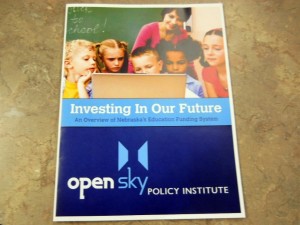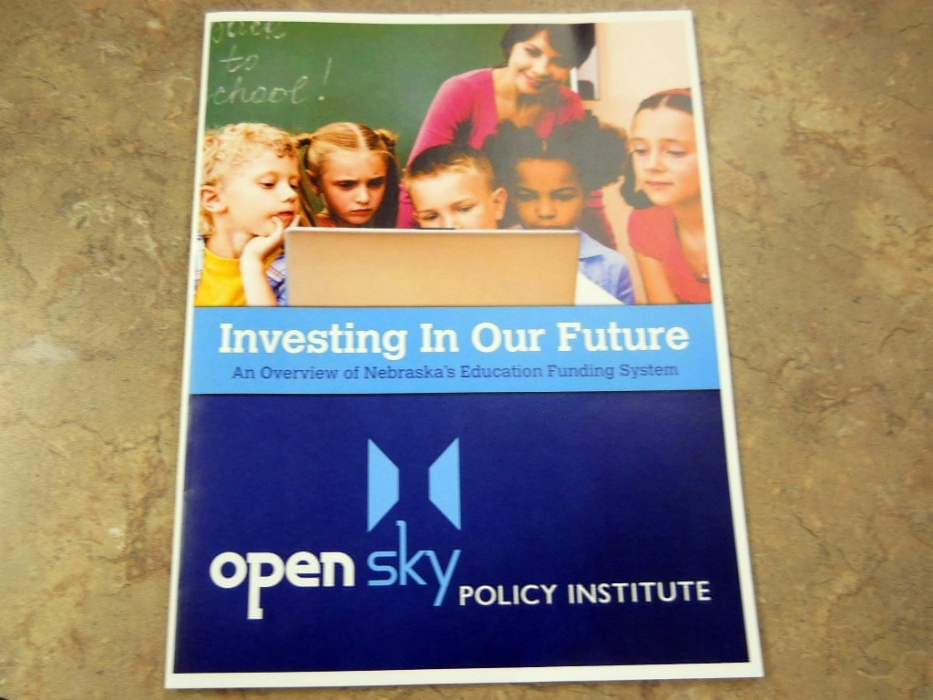OpenSky Policy Institute has released its new report on K-12 funding: “Investing in Our Future: An Overview of Nebraska’s Education Funding System.”
Given the complexity and importance of our education finance system, OpenSky produced this primer to promote a dialogue on the vital issues surrounding how Nebraska funds K-12 education.
OpenSky Policy Institute is a nonprofit, nonpartisan organization focused on budget and tax policy. About a year ago we expanded our work to look at education finance, as it became clear that how we fund K-12 education is integral to both budget and tax policy.
In the primer we explore how Nebraska has paid for K-12 education in the past, how it does so now, and discuss the perceived inequities of our current system.
Download a copy of the report here.
OpenSky Executive Director Renee Fry said: “One of the most striking findings is Nebraska’s historical reliance on local sources of revenue, such as property taxes, to fund public schools. In fact, every tax study since 1962 has noted heavy reliance on property taxes and low level of state support for K-12.
“Despite the best intentions to reduce our reliance on property taxes, Nebraska’s K-12 schools are more reliant on local sources of revenue than schools in any other state in the nation,” Fry said. “Such heavy reliance on local revenues has fueled the debate over how to make state funding equitable between districts that have high property values for tax purposes and those that don’t.
“Nebraska’s changing demographics — a declining rural population, skyrocketing agricultural land values and increased student needs in many areas — have made this balance even more challenging,” Fry said. “But with challenges come opportunity, and we hope this primer will help shape a more productive discussion about how Nebraska funds K-12 education now and in the years to come.”
Among the highlights of the report:
— Nebraska has always relied heavily on property taxes to fund K-12 education. In 1990, Nebraska ranked 49th nationally for the percentage of K-12 funding provided by the state. Despite legislative efforts to significantly increase state support, Nebraska still ranked 49th nationally in the percentage of state support for schools in FY 2012.
— In fact, our school funding mix has changed little since the implementation of our current funding system.
— A heavy reliance on property taxes and relatively low state support creates taxing inequities, which have driven much of the debate on how best to finance education. In 1989/90, tax rates ranged from 75 cents to $3.25 per $100 of property tax valuation. The range of tax rates in 2012/13 was 43 cents to $1.20. So while the range has narrowed considerably, the highest tax rates are almost three times the lowest rates.
— In addition to tax rate inequities, school districts with high property values are able to spend nearly twice as much per pupil as those with low property values. Now, some districts may need to spend that much to offer high-quality educational opportunities in the face of challenges such as high poverty, high transportation needs, and small student populations that make it difficult to take advantage of economies of scale. But the districts that can spend the most may not always be the districts with the highest needs. Our funding system could do more to address these sorts of inequities and ensure that every school has access to the resources it needs to provide a first-rate education for its students.
— Furthermore, the districts with the lowest property wealth also have, on average, the highest tax rates. So while per-pupil spending can vary for many reasons, the fact that those districts with the lowest spending and the lowest property wealth tend to have the highest tax levies warrants further discussion.
— Because the state aid formula relies so heavily on local property values to calculate the resources of schools, the result is that urban school districts need more state aid even though they tend to have higher property tax rates.
— At the same time, the rural districts are seeing a loss of state aid due to increasing agricultural land valuations. However, agricultural landowners are not seeing incomes rise as fast as land values, so more of their income is being taken up by increased property taxes.
— These dynamics have fueled the ongoing rift in the Legislature and pitted urban and rural school districts against each other in the fight for state funding.
So while we hope this primer helps Nebraskans understand how and why today’s funding is structured as it is, we are left with some important questions:
— How can Nebraska create an education finance system that fosters quality, fairness and equity when some schools have four times as much property value per student as other schools?
— Should the state assume a larger role in K-12 finance and, in effect, reduce property tax reliance?
— Or is a more fundamental revision of the school funding system needed?
— For example, is property value an appropriate measure of community resources in today’s economy, or is it time to look at determining the wealth of a school district based on the income of its residents or some other measures?
For more information or to schedule an interview, please contact OpenSky Communications Director Chuck Brown at cbrown@openskypolicy.org or(402) 438-0386.



